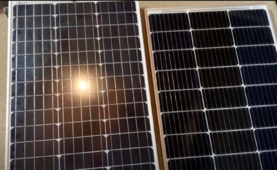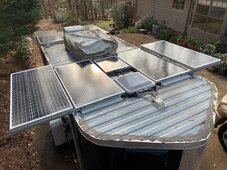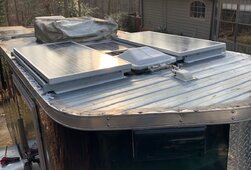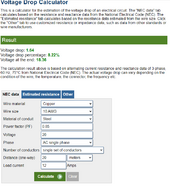0truck0
New Member
I am building a sliding solar panel with these 100w .
The plan is that the top one slides out when parked, when needed, and doubles the solar capture. A 100 w over another 100w, and on both sides of trailer.
I have substantial wires inside, so the question is NOT about wires or what wires do, please I do not need info on wires...
Anyone see any issues if I run the two panels parallel down the same wire? The controller will be fine. **edit, I ran new cables. new controller, so trailer has 3 complete sets of solar systems and two sets of batteries.**
The shaded panel and the top (always in sun) panel wired together parallel (go into the same positive wire / going to controller and to same negative wire).
Two 100w panels in series (the two top panels always in sun) and two 100w panels (lower panels) in series also. So, this is a 200 w 24v (36v) (each panels says 5.8 amps) times two. At full sun, fully deployed, this is 400 watts, 24v, when not deployed is only 200 watts 24v, and the other 200 watts 0v is in the shade.
And, if you dont understand please hold off comments as dont want forum filled with unrelated comments, just DM me first.
The question is:
Is there any issue having a dark panel connected to same wires as sunlight panel? Will the dark panels suck wattage?

Panels will be stacked, and the lower one will be completely in the dark when closed, and fully in sun when open.

The plan is that the top one slides out when parked, when needed, and doubles the solar capture. A 100 w over another 100w, and on both sides of trailer.
I have substantial wires inside, so the question is NOT about wires or what wires do, please I do not need info on wires...
Anyone see any issues if I run the two panels parallel down the same wire? The controller will be fine. **edit, I ran new cables. new controller, so trailer has 3 complete sets of solar systems and two sets of batteries.**
The shaded panel and the top (always in sun) panel wired together parallel (go into the same positive wire / going to controller and to same negative wire).
Two 100w panels in series (the two top panels always in sun) and two 100w panels (lower panels) in series also. So, this is a 200 w 24v (36v) (each panels says 5.8 amps) times two. At full sun, fully deployed, this is 400 watts, 24v, when not deployed is only 200 watts 24v, and the other 200 watts 0v is in the shade.
And, if you dont understand please hold off comments as dont want forum filled with unrelated comments, just DM me first.
The question is:
Is there any issue having a dark panel connected to same wires as sunlight panel? Will the dark panels suck wattage?

Panels will be stacked, and the lower one will be completely in the dark when closed, and fully in sun when open.

Last edited:






